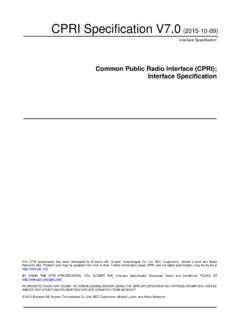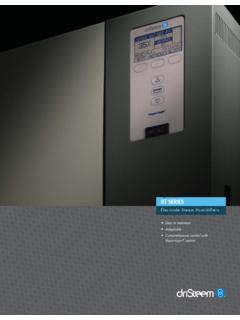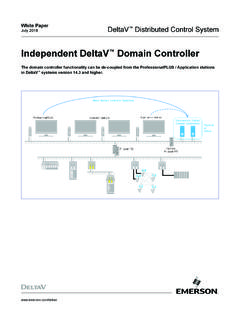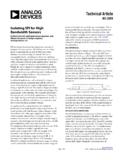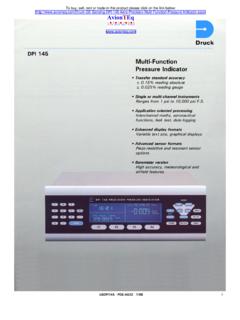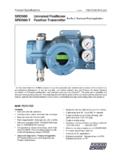Transcription of www.ti.com SPRS605C – JULY 2009– REVISED JUNE 2012 ...
1 TMS320DM6467T. SPRS605C JULY 2009 REVISED JUNE 2012. TMS320DM6467T. Digital media System-on-Chip Check for Samples: TMS320DM6467T. 1 Digital media System-on-Chip (DMSoC). 12. Features High-Performance Digital media SoC 128K-Byte L2 Unified Mapped RAM/Cache 1-GHz C64x+ Clock Rate (Flexible RAM/Cache Allocation). 500-MHz ARM926EJ-S Clock Rate ARM926EJ-S Core Eight 32-Bit C64x+ Instructions/Cycle Support for 32-Bit and 16-Bit (Thumb . Mode) Instruction Sets 8000 C64x+ MIPS. DSP Instruction Extensions and Single Cycle Fully Software-Compatible With C64x /. MAC. ARM9 . ARM Jazelle Technology Industrial Temperature Devices Available EmbeddedICE-RT Logic for Real-Time Advanced Very-Long-Instruction-Word (VLIW). Debug TMS320C64x+ DSP Core ARM9 Memory Architecture Eight Highly Independent Functional Units 16K-Byte Instruction Cache Six ALUs (32-/40-Bit), Each Supports Single 32-Bit, Dual 16-Bit, or Quad 8-Bit 8K-Byte Data Cache Arithmetic per Clock Cycle 32K-Byte RAM.
2 Two Multipliers Support Four 16 x 16-Bit 8K-Byte ROM. Multiplies (32-Bit Results) per Clock Embedded Trace Buffer (ETB11 ) With 4KB. Cycle or Eight 8 x 8-Bit Multiplies (16-Bit Memory for ARM9 Debug Results) per Clock Cycle Endianness: Little Endian for ARM and DSP. Load-Store Architecture With Non-Aligned Dual Programmable High-Definition Video Support Image Co-Processor (HDVICP) Engines 64 32-Bit General-Purpose Registers Supports a Range of Encode, Decode, and Instruction Packing Reduces Code Size Transcode Operations All Instructions Conditional , MPEG2, VC1, MPEG4 SP/ASP. Additional C64x+ Enhancements 150-MHz Video Port Interface (VPIF). Protected Mode Operation Two 8-Bit SD ( ), Single 16-Bit HD. Exceptions Support for Error Detection ( ), or Single Raw (8-/10-/12-Bit) Video and Program Redirection Capture Channels Hardware Support for Modulo Loop Two 8-Bit SD ( ) or Single 16-Bit HD. Operation ( ) Video Display Channels C64x+ Instruction Set Features Video Data Conversion Engine (VDCE).
3 Byte-Addressable (8-/16-/32-/64-Bit Data) Horizontal and Vertical Downscaling 8-Bit Overflow Protection Chroma Conversion (4:2:2 4:2:0). Bit-Field Extract, Set, Clear Two Transport Stream Interface (TSIF) Modules Normalization, Saturation, Bit-Counting (One Parallel/Serial and One Serial Only). Compact 16-Bit Instructions TSIF for MPEG Transport Stream Additional Instructions to Support Complex Simultaneous Synchronous or Multiplies Asynchronous Input/Output Streams C64x+ L1/L2 Memory Architecture Absolute Time Stamp Detection 32K-Byte L1P Program RAM/Cache (Direct PID Filter With 7 PID Filter Tables Mapped) Corresponding Clock Reference Generator 32K-Byte L1D Data RAM/Cache (2-Way Set- (CRGEN) Modules for System Time-Clock Associative) Recovery 1. Please be aware that an important notice concerning availability, standard warranty, and use in critical applications of Texas Instruments semiconductor products and disclaimers thereto appears at the end of this data sheet.
4 2 All trademarks are the property of their respective owners. PRODUCTION DATA information is current as of publication date. Products conform to Copyright 2009 2012, Texas Instruments Incorporated specifications per the terms of the Texas Instruments standard warranty. Production processing does not necessarily include testing of all parameters. TMS320DM6467T. SPRS605C JULY 2009 REVISED JUNE 2012 External Memory Interfaces (EMIFs) SIR and MIR ( MBAUD). Up to 400-MHz 32-Bit DDR2 SDRAM Memory CIR With Programmable Data Encoding Controller With 512M-Byte Address Space One Serial Peripheral Interface (SPI) With Two ( I/O) Chip-Selects Asynchronous16-Bit Wide EMIF (EMIFA) Master/Slave Inter-Integrated Circuit (I2C Bus ). With 128M-Byte Address Reach Two Multichannel Audio Serial Ports (McASPs). Flash Memory Interfaces One Four Serializer Transmit/Receive Port NOR (8-/16-Bit-Wide Data) One Single DIT Transmit Port for S/PDIF. NAND (8-/16-Bit-Wide Data) 32-Bit Host Port Interface (HPI).
5 Enhanced Direct-Memory-Access (EDMA) VLYNQ Interface (FPGA Interface). Controller (64 Independent Channels). Two Pulse Width Modulator (PWM) Outputs Programmable Default Burst Size ATA/ATAPI I/F (ATA/ATAPI-6 Specification). 10/100/1000 Mb/s Ethernet MAC (EMAC). Up to 33 General-Purpose I/O (GPIO) Pins IEEE Compliant ( I/O Only) (Multiplexed With Other Device Functions). Supports MII and GMII media Independent On-Chip ARM ROM Bootloader (RBL). Interfaces Individual Power-Saving Modes for ARM/DSP. Management Data I/O (MDIO) Module Flexible PLL Clock Generators USB Port With Integrated PHY. (JTAG) Boundary- USB High-/Full-Speed Client Scan-Compatible USB High-/Full-/Low-Speed Host 529-Pin Pb-Free BGA Package (Mini-Host, Supporting One External (CUT Suffix), Ball Pitch Device). m/7-Level Cu Metal Process (CMOS). 32-Bit, 66-MHz, V Peripheral Component and I/O, Internal Interconnect (PCI) Master/Slave Interface Applications: Conforms to PCI Specification Video Encode/Decode/Transcode/Transrate Two 64-Bit General-Purpose Timers (Each Configurable as Two 32-Bit Timers) Digital media One 64-Bit Watch Dog Timer Networked media Encode/Decode Three Configurable UART/IrDA/CIR Modules Video Imaging (One With Modem Control Signals) Video Infrastructure Supports up to Mbps UART Video Conferencing 2 Digital media System-on-Chip (DMSoC) Copyright 2009 2012, Texas Instruments Incorporated Submit Documentation Feedback Product Folder Link(s): TMS320DM6467T.
6 TMS320DM6467T. SPRS605C JULY 2009 REVISED JUNE 2012. Description The TMS320DM6467T (also referenced as DM6467T) leverages TI's DaVinci technology to meet the networked media encode and decode digital media processing needs of next-generation embedded devices. The DM6467T enables OEMs and ODMs to quickly bring to market devices featuring robust operating systems support, rich user interfaces, high processing performance, and long battery life through the maximum flexibility of a fully integrated mixed processor solution. The dual-core architecture of the DM6467T provides benefits of both DSP and Reduced Instruction Set Computer (RISC) technologies, incorporating a high-performance TMS320C64x+ DSP core and an ARM926EJ-S core. The ARM926EJ-S is a 32-bit RISC processor core that performs 32-bit or 16-bit instructions and processes 32-bit, 16-bit, or 8-bit data. The core uses pipelining so that all parts of the processor and memory system can operate continuously.
7 The ARM core incorporates: A coprocessor 15 (CP15) and protection module Data and program Memory Management Units (MMUs) with table look-aside buffers. Separate 16K-byte instruction and 8K-byte data caches. Both are four-way associative with virtual index virtual tag (VIVT). The TMS320C64x+ DSPs are the highest-performance fixed-point DSP generation in the TMS320C6000 DSP platform. It is based on an enhanced version of the second-generation high- performance, advanced very-long-instruction-word (VLIW) architecture developed by Texas Instruments (TI), making these DSP cores an excellent choice for digital media applications. The C64x is a code- compatible member of the C6000 DSP platform. The TMS320C64x+ DSP is an enhancement of the C64x+ DSP with added functionality and an expanded instruction set. Any reference to the C64x DSP or C64x CPU also applies, unless otherwise noted, to the C64x+ DSP and C64x+ CPU, respectively. With performance of up to 8000 million instructions per second (MIPS) at a clock rate of 1 GHz, the C64x+.
8 Core offers solutions to high-performance DSP programming challenges. The DSP core possesses the operational flexibility of high-speed controllers and the numerical capability of array processors. The C64x+ DSP core processor has 64 general-purpose registers of 32-bit word length and eight highly independent functional units two multipliers for a 32-bit result and six arithmetic logic units (ALUs). The eight functional units include instructions to accelerate the performance in video and imaging applications. The DSP core can produce four 16-bit multiply-accumulates (MACs) per cycle for a total of 4000 million MACs per second (MMACS), or eight 8-bit MACs per cycle for a total of 8000 MMACS. For more details on the C64x+ DSP, see the TMS320C64x/C64x+ DSP CPU and Instruction Set Reference Guide (literature number SPRU732). The DM6467T also has application-specific hardware logic, on-chip memory, and additional on-chip peripherals similar to the other C6000 DSP platform devices.
9 The DM6467T core uses a two-level cache- based architecture. The Level 1 program cache (L1P) is a 256K-bit direct mapped cache and the Level 1. data cache (L1D) is a 640K-bit 2-way set-associative cache. The Level 2 memory/cache (L2) consists of an 512K-bit memory space that is shared between program and data space. L2 memory can be configured as mapped memory, cache, or combinations of the two. The peripheral set includes: a configurable video port; a 10/100/1000 Mb/s Ethernet MAC (EMAC) with a Management Data Input/Output (MDIO) module; a 4-bit transfer/4-bit receive VLYNQ interface; an inter- integrated circuit (I2C) Bus interface; a multichannel audio serial port (McASP0) with 4 serializers; a secondary multichannel audio serial port (McASP1) with a single transmit serializer; 2 64-bit general- purpose timers each configurable as 2 independent 32-bit timers; 1 64-bit watchdog timer; a configurable 32-bit host port interface (HPI); up to 33-pins of general-purpose input/output (GPIO) with programmable Copyright 2009 2012, Texas Instruments Incorporated Digital media System-on-Chip (DMSoC) 3.
10 Submit Documentation Feedback Product Folder Link(s): TMS320DM6467T. TMS320DM6467T. SPRS605C JULY 2009 REVISED JUNE 2012 interrupt/event generation modes, multiplexed with other peripherals; 3 UART/IrDA/CIR interfaces with modem interface signals on UART0; 2 pulse width modulator (PWM) peripherals; an ATA/ATAPI-6. interface; a 66-MHz peripheral component interface (PCI); and 2 external memory interfaces: an asynchronous external memory interface (EMIFA) for slower memories/peripherals, and a higher speed synchronous memory interface for DDR2. The Ethernet media Access Controller (EMAC) provides an efficient interface between the DM6467T and the network. The DM6467T EMAC support both 10 Base-T and 100 Base-TX, or 10 Mbits/second (Mbps). and 100 Mbps in either half- or full-duplex mode; and 1000 Base-TX (1 Gbps) in full-duplex mode with hardware flow control and quality of service (QOS) support. The Management Data Input/Output (MDIO) module continuously polls all 32 MDIO addresses in order to enumerate all PHY devices in the system.










